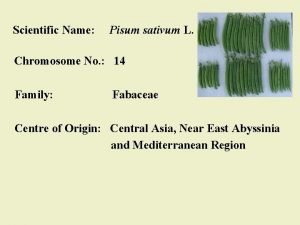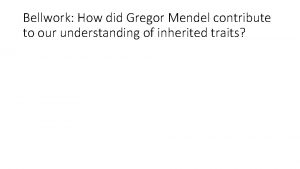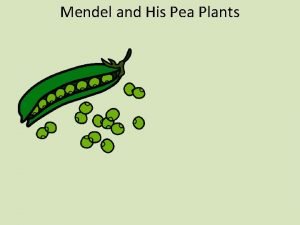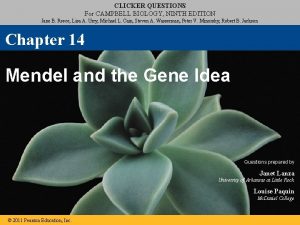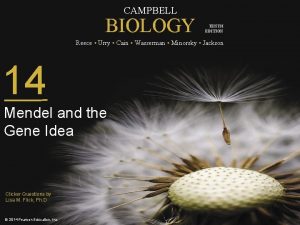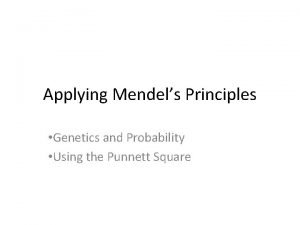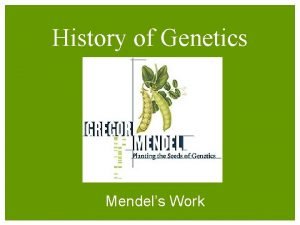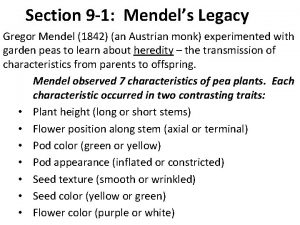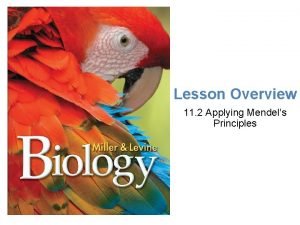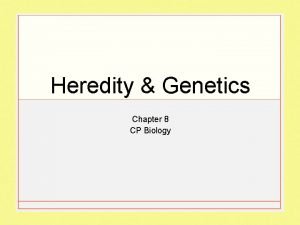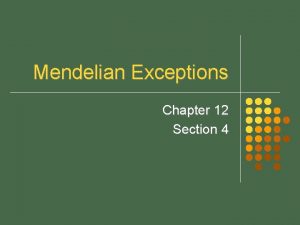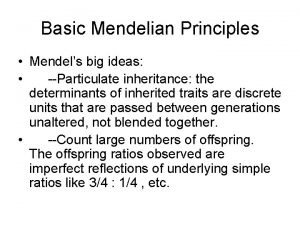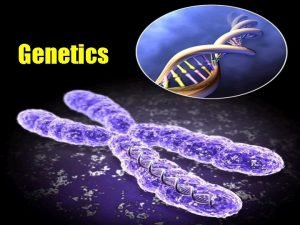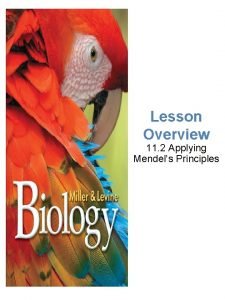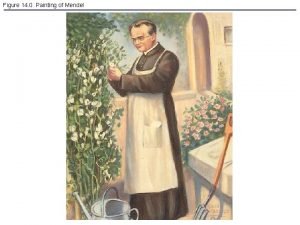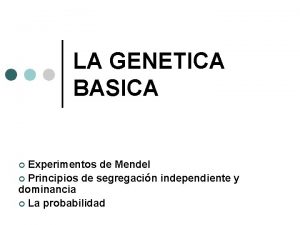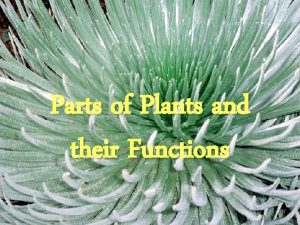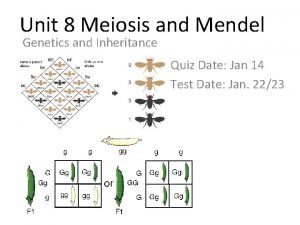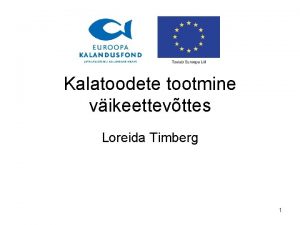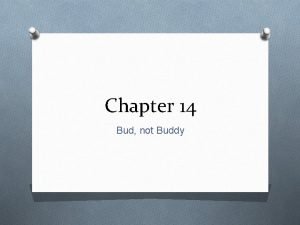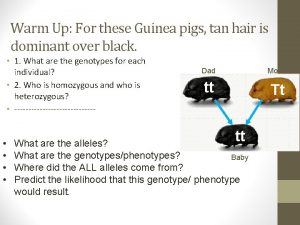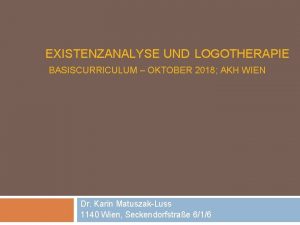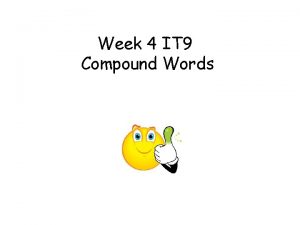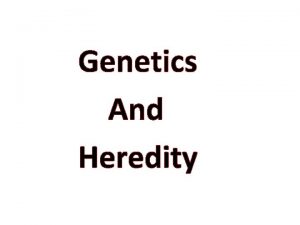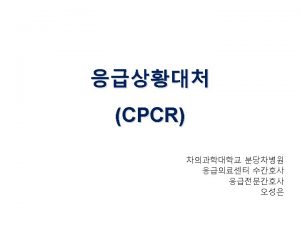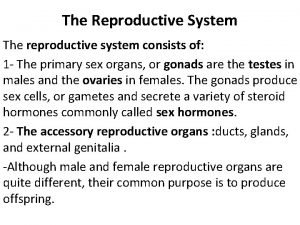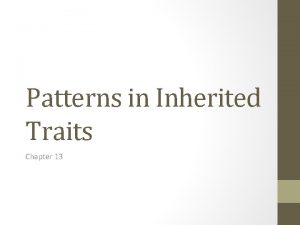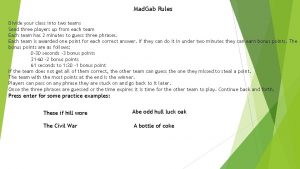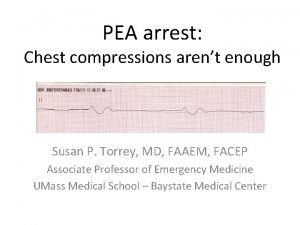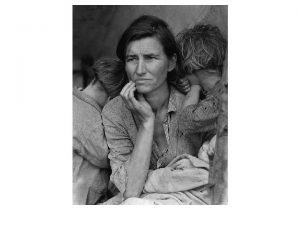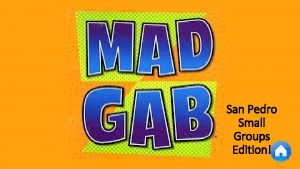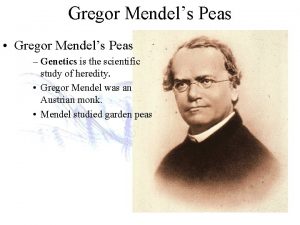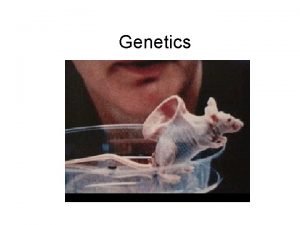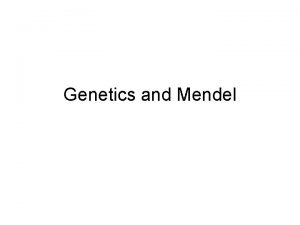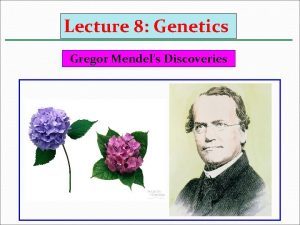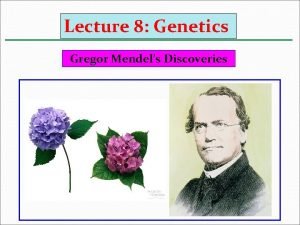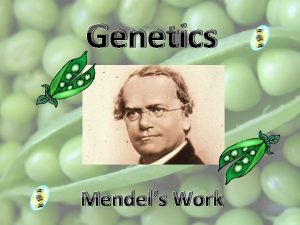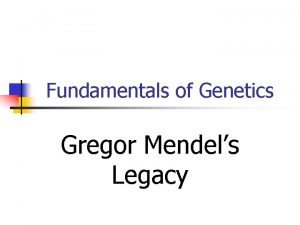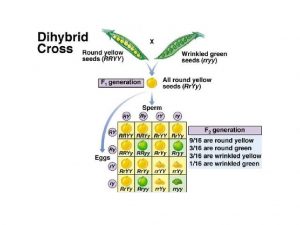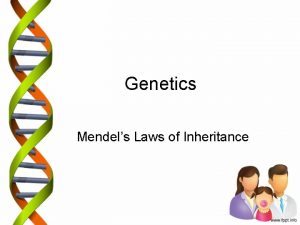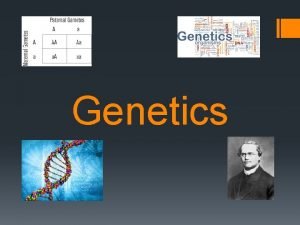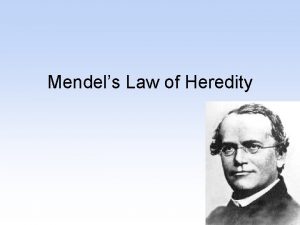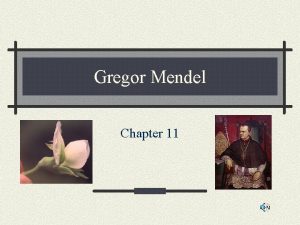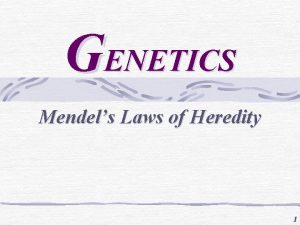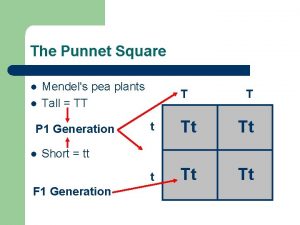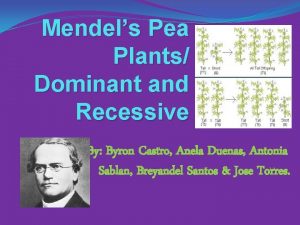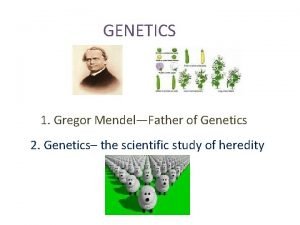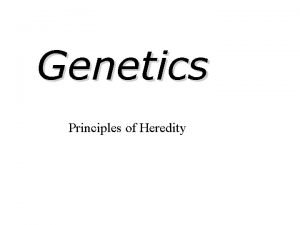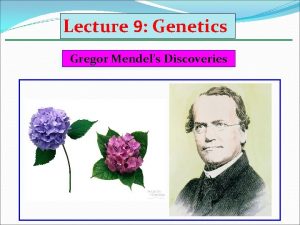Genetics Part 1 Gregor Mendels pea plants Part
































![Punnett Squares [See worksheet] Single gene crosses with regular dominance Punnett Squares [See worksheet] Single gene crosses with regular dominance](https://slidetodoc.com/presentation_image_h2/00b5834431cfb1f312e3873f6c5b2b0b/image-33.jpg)







































- Slides: 72

Genetics Part 1: Gregor Mendel’s pea plants Part 2: Punnett squares Part 3: More genetics Bonus: Albinism

Genetic Traits Widow’s peak

Genetic Traits Albinism

Genetic Traits Attached and unattached earlobes

Genetic Traits Hitchhiker’s thumb Regular thumb

Genetic Traits Cleft chin

Genetic Traits Tongue roll

Genetics is the scientific study of heredity which is the passing of traits from parents to offspring. – Occurs in all organisms – Through DNA

Fertilization • The process in which male and female gametes join to produce a zygote 23 + 23 46 A zygote is a fertilized egg. It starts as one cell and then grows into a new organism.

Gametes • Specialized cells involved in sexual reproduction (sex cells) – Ex: sperm (male) eggs (female)

Gametes • Each gamete contains one set of chromosomes from the parent 23 23 (gametes) 23 + 23 46 46 (zygote)

Gametes • Each gamete contains one set of chromosomes from the parent

How do traits get passed down? A gene is a section of DNA that determines a particular trait by coding for specific proteins Ex: eye color gene

How do traits get passed down? There are many different eye colors! Possible colors = brown, blue, gray, green, etc.

How do traits get passed down? An allele is a specific form of a gene. Example: brown eyes allele blue eyes allele

How do traits get passed down? An allele is a specific form of a gene. Example: For the gene for flower color, a pea plant can have a white allele or a purple allele.

Mendel’s Principles 1. Principle of Dominance: Some alleles are dominant and others are recessive. An organism with the dominant allele for a particular trait will always exhibit that trait.

Mendel’s Principles 1. Principle of Dominance: Some alleles are dominant and others are recessive. Dominant: Brown hair Can curl tongue Pigmented skin Brown eyes Recessive: Red hair Cannot curl tongue Albinism Blue eyes

How do traits get passed down? Alleles are represented by letters. Examples: B = brown eyes (dominant is uppercase) b = blue eyes (recessive is lowercase) T = tall t = short

How do traits get passed down? Organisms have two copies of each gene. BB = brown eyes Bb = brown eyes bb = blue eyes

Genetics Genotype: the genetic makeup of an organism (what genes it has) Ex: Bb or bb Phenotype: the physical appearance (what traits it expresses) Ex: brown or blue eyes

Genetics Two organisms can have the same phenotype but different genotypes. Ex: Phenotype = brown eyes Possible genotypes = BB and Bb

Genetics Homozygous: having two identical alleles for a particular trait Ex: TT or tt (true-breeding) Heterozygous: having two different alleles for the same trait Ex: Tt (hybrid)

Homozygous or heterozygous?

Mendel’s Principles 2. Principle of Segregation: The two alleles for a trait separate during gamete formation. Parent cell Bb Each gamete has only one set of genes. B b Gametes

Father Bb Bb Mother B b BB Bb Bb bb The probability of getting each allele is the same (50%).

Punnett Squares Punnett squares are diagrams that show gene combinations that might result from genetic crosses.

Probability is the likelihood that an event is going to happen. Ex: The probability of picking a queen from a deck of cards is 4/52, or 1/13. Ex: The probability of two parents having a boy is 1/2.

Punnett Squares Let’s cross two parents with the following genotypes: BB and bb F 1 offspring all have Bb b genotype. B B Bb Bb Phenotype? Bb Bb b

Punnett Squares Now let’s cross two of the F 1 offspring with each other. F 1 cross: F 2 offspring have genotype B ratio of 1 : 2 : 1 (BB : Bb : bb) Phenotype ratio? b 3: 1 B b BB Bb Bb bb


Punnett Squares Cross a homozygous tall plant with a heterozygous plant. TT x Tt Tall (T) Short (t) T T What percentage of the offspring will be tall? T TT TT What percentage of the offspring will be homozygous? t Tt Tt
![Punnett Squares See worksheet Single gene crosses with regular dominance Punnett Squares [See worksheet] Single gene crosses with regular dominance](https://slidetodoc.com/presentation_image_h2/00b5834431cfb1f312e3873f6c5b2b0b/image-33.jpg)
Punnett Squares [See worksheet] Single gene crosses with regular dominance

Independent Assortment Dihybrid cross: follows the inheritance of TWO traits Ex: seed shape AND seed color

Independent Assortment Seed shape R = round r = wrinkled Seed color Y = yellow y = green

Independent Assortment RRYY x rryy (round yellow) (wrinkled green) Rr. Yy (round yellow)

Independent Assortment • Try crossing two heterozygous round yellow peas: Rr. Yy x Rr. Yy • What are the phenotype ratios of the offspring?


Independent Assortment • New phenotypes that were NOT seen in original parents!! – Round green – Wrinkled yellow • If RY and ry were linked, you’d only be able to get parent phenotypes • 9 : 3 : 1 phenotype ratio

Mendel’s 3 Principles 3. Principle of Independent Assortment: Alleles of different genes segregate independently during the formation of gametes. • • Traits are inherited separately from each other Ex: Having brown eyes has nothing to do with how tall you are, or (in peas) flower color is not related to seed color

Dihybrid Cross Ggbb = gray hair, red eyes ggbb = white hair, red eyes gg. BB = white hair, black eyes Gg. Bb = gray hair, black eyes

FOIL (First, Outside, Inside, Last) Gg Bb x Gg Bb GB Gb g. B gb

#3 GB GB Gb g. B gb

Dihybrid Cross Create a dihybrid cross for the following two individuals: gg. BB x GGBb G = gray hair g = white hair B = black eyes b = red eyes

#4 g. B GB GB Gb Gb g. B gb gb

FOIL (First, Outside, Inside, Last) gg Bb x GG Bb g. B gb GB Gb

#4 g. B gb gb GB Gg. BB Gg. Bb Gb Gg. Bb Ggbb

#4 g. B gb gb GB Gg. BB Gg. Bb Gb Gg. Bb Ggbb

More Inheritance Patterns • We’ve been dealing with complete dominance – One allele is dominant to the other – 2 alleles per trait • But there are OTHER types of genes that can be inherited

More Inheritance Patterns 4 New Types: • Incomplete dominance • Codominance • Multiple alleles • Polygenic traits

More Inheritance Patterns 2 Key Ideas: • Not alleles are completely dominant or recessive • Some traits are controlled by multiple alleles or genes

Journal: Describe how flower color is inherited in the snapdragon. This illustration shows the cross between a red snapdragon flower and a white snapdragon flower.

Incomplete Dominance • Neither trait is dominant • Offspring exhibits a blend of parent phenotypes

Codominance • Both traits are dominant • Offspring exhibits both traits side-byside

Incomplete Dominance Example: A cross between a blue bird and a white bird produces silver-blue offspring. (The color of these birds is determined by just 2 alleles. ) 1. What are the genotypes of the parent birds? 2. What is the genotype of the offspring? 3. Show a cross between 2 of the offspring. What are the phenotypic ratios?

Codominance Example: Cattle can be red (all red hair), white (all white hair), or roan (red and white hairs together). 1. What is the genotype of a roan cow? 2. Show a cross between a homozygous white cow and a roan bull. 3. What are the phenotypic ratios of the offspring?

Codominance A roan bull

Codominance Black-and-white chicken

Incomplete Dominance What to look for: • A 3 rd phenotype (different from parents) • A blend of parents’ phenotypes

Codominance What to look for: • Both parents’ traits appear in the same organism

Multiple Alleles • 3 or more different alleles • Each individual still has only 2 Ex: rabbit coat color C Cch Ch c = full color = chinchilla = himalayan = white

Multiple Alleles Allele C Cch Ch Color Full color Chinchilla Himalayan c White Question: Give the coat colors of the following rabbits: 1. CCh 2. Chc 3. Cch. Ch 4. cc

Polygenic Traits • 2 or more genes contribute to a trait • Large variety of phenotypes Ex: Skin color Hair color Height

Polygenic Traits

Multiple Alleles Example: There are 3 possible alleles for human blood type. Each individual has only 2. IA and IB are codominant, and i is recessive to both. IAIA = Type A IBIB = Type B IAIB = Type AB IA i = Type A IB i = Type B ii = Type O 1. How many different genotypes are possible? 2. How many different phenotypes are possible? 3. Show a cross between a heterozygous Type A father and a heterozygous Type B mother.

A-B-O Blood Types Problem 1: A man with Type A blood marries a woman with Type A blood. Their first child is Type O. What are the genotypes of all three?

A-B-O Blood Types Problem 2: A husband wife both have Type A blood. The man’s father was AB and mother was B. The woman’s father was A and mother was B. What is the probability that their first child will also be Type A?

A-B-O Blood Types Problem 3: Three babies are accidentally mixed up in a hospital. Match the babies with their parents using their blood type info. Baby Blood Type Parents Blood Types 1 2 3 AB B O 1 2 3 AB and O A and B B and AB

Journal: What is the difference between incomplete and codominance? Give examples.

Polygenic Traits Example: Human skin pigmentation (skin color) comes in a large range of phenotypes.

Polygenic Traits Example: A graph of a polygenic trait usually makes a bell curve. 1. What phenotypes are most common? 2. What phenotypes are least common? Human skin color

Albinism • Hereditary condition • Gene does not make the usual amounts of melanin, which is a pigment (color) in skin and hair • Sunburn easily
 Gregor mendels principles of genetics apply to
Gregor mendels principles of genetics apply to Gregor mendel plant
Gregor mendel plant Mendel
Mendel Difference between field pea and garden pea
Difference between field pea and garden pea How did gregor mendel contribute to genetics
How did gregor mendel contribute to genetics Pp x pp
Pp x pp Chapter 11 biology test
Chapter 11 biology test Homozygous recessive
Homozygous recessive Pea plants were particularly well suited
Pea plants were particularly well suited Pea plants were particularly well suited
Pea plants were particularly well suited Applying mendels principles
Applying mendels principles 11.2 applying mendel's principles
11.2 applying mendel's principles Mendels
Mendels 9-1 mendels legacy
9-1 mendels legacy Chapter 12 lesson 2 applying mendels principles
Chapter 12 lesson 2 applying mendels principles Mendels law of segregation
Mendels law of segregation Mendels law
Mendels law Mendels sps
Mendels sps Mendels two laws
Mendels two laws Chapter 12 lesson 2 applying mendels principles
Chapter 12 lesson 2 applying mendels principles Mendels fabric
Mendels fabric Mendels law of segregation states that
Mendels law of segregation states that Mendels theory
Mendels theory Mendels first law
Mendels first law Applying mendel's principles
Applying mendel's principles Applying mendels principles
Applying mendels principles Mendel
Mendel 3 laws in law of inheritance
3 laws in law of inheritance Mendels laws
Mendels laws Mendels en linea
Mendels en linea Classification of flowering and non flowering plants
Classification of flowering and non flowering plants C3 plant
C3 plant Vascular plants
Vascular plants Nonvascular plants reproduction
Nonvascular plants reproduction Plants parts and function
Plants parts and function Different part of plants
Different part of plants Haploid karyotype
Haploid karyotype Pia e pea
Pia e pea Ikke stødbar rytme
Ikke stødbar rytme Pea ekg
Pea ekg Complementary genes in sweet pea
Complementary genes in sweet pea Prototipos desechables
Prototipos desechables Pericarp of pea
Pericarp of pea Kalahakkliha ehk
Kalahakkliha ehk Gambaran pea
Gambaran pea What is the sweet pea in bud not buddy
What is the sweet pea in bud not buddy Pyr
Pyr Jim gallien
Jim gallien Punnett square
Punnett square Example of pee paragraph
Example of pee paragraph Pea existenzanalyse
Pea existenzanalyse What is the problem
What is the problem Compound words with coat
Compound words with coat Narrative text structure
Narrative text structure Vapor de ozonio htm
Vapor de ozonio htm Chromosome 4
Chromosome 4 Pea collective agreement
Pea collective agreement Botanical name of garden pea
Botanical name of garden pea Freytag's plot structure
Freytag's plot structure Components of high quality cpr
Components of high quality cpr Female reproductive system definition
Female reproductive system definition Peamaster
Peamaster Pea brush
Pea brush Pea
Pea Pea plant flower color
Pea plant flower color Wand her womb hen
Wand her womb hen Pea causes
Pea causes Tipos de energia
Tipos de energia Signore dammi la forza di accettare
Signore dammi la forza di accettare Norma rydlewski
Norma rydlewski Causes of pea
Causes of pea Dawn dude rugs
Dawn dude rugs Peas salud
Peas salud



